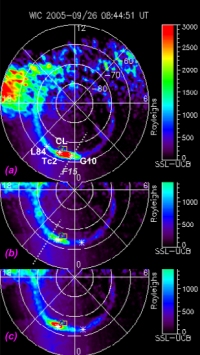Cluster and Double Star pinpoint the source of bright aurorae
11 September 2007
Colourful aurorae and perturbations of GPS signals are just some of the effects of a magnetospheric phenomenon known as a magnetic substorm. Up to now, the onset of this phenomenon has been explained by two competing models: current disruption and near-Earth reconnection. A new study published 20 January 2007 in Geophysical Research Letters challenges this binary vision of substorm onset. Thanks to simultaneous measurements performed by the four satellites of the ESA/NASA Cluster mission and the CNSA/ESA Double star mission, a third type of substorm onset is now suggested.
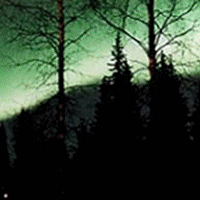 |
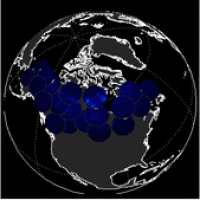 |
|
Animation 1. Sequence of images showing auroral brightening during a substorm. |
Animation 2. Auroral brightening due to substorms over Canada. |
Very bright and colourful aurorae due to magnetic substorms are often observed at high latitudes such as Scandinavia or Canada (Animation 1 and 2). These aurorae are primarily caused by energetic electrons spiralling down the Earth's magnetic field lines and colliding with atmospheric atoms at altitudes of ~100 km. The energetic electrons come from within the Earth's magnetotail.
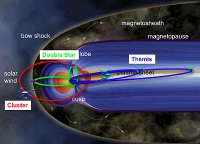 |
|
Image 1. Artistic view of all 11 spacecraft from the Cluster, Double Star and THEMIS mission orbiting the Earth. |
The magnetotail is a region of space located on the nightside of Earth where the solar wind stretches out terrestrial magnetic field lines into a long tail. In its centre, a denser region known as the plasma sheet is present (Image 1).
A substorm induces violent changes of the characteristics of the plasma sheet. It energizes ions and electrons and hurls them Earthward and substorms can occur as a series or in isolation. Apart from the beautiful light show, substorms also excite a large portion of the Earth's ionosphere, perturbing the reception of GPS signals and communications between Earth and orbiting satellites. Despite decades of space research, the onset mechanism of substorms remains a mystery.
What scientists agree on is that three events are associated with the substorm onset: 1) auroral brightening, 2) current disruption, and 3) magnetic reconnection. The auroral brightening is what is visible from the ground: a sudden change of the aurora from light grey to very bright and colourful aurorae at ~100 km altitude (Animation 1). The current disruption occurs at roughly 60 000 km altitude on the nightside, or ~1/6 the distance to the Moon and is associated with large amplitude and turbulent magnetic field fluctuations. Years of data collected in space have shown that magnetic reconnection, which heats and accelerates plasma, occurs on average at around 1/3 the distance to the Moon or 120 000 km, in a thin plane close to the magnetic equator of the magnetotail.
So far, space scientists generally believed that these events occur in one of the two following sequences
|
| ||||||||||||||||||||
However, a recent study published 20 January 2007 in Geophysical Research Letters, challenges this vision of substorm onset, thanks to a fortuitous spacecraft constellation of the four satellites composing the ESA/NASA Cluster mission and the two satellites of the CNSA/ESA Double Star mission (Image 2).
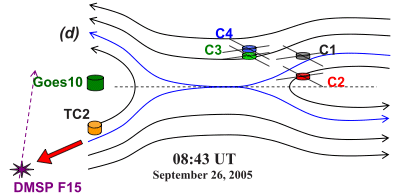 |
|
Image 2. Schematic of spacecraft positions mapped onto the 23 h Magnetic Local Time (MLT) meridional plane during an auroral brightening event (event 'a', see Image 3). |
Data collected on 26 September 2005 between 08 and 10 UT captured the occurrence of three consecutive substorm onsets. But for the first time, these data indicate that the current disruption process and magnetic reconnection can coincide in space and time showing possibly the two sides of the same process. Professor Sergeev (St Petersburg State University, Russia) and co-authors also found that in this case, magnetic reconnection occurred closer to the Earth than usual, almost co-located with the current disruption process, between 60 000 km and 90 000 km. Related localized auroral brightenings were captured a few tens of seconds later by an ultra violet (UV) imager onboard the NASA IMAGE satellite (Image 3).
"These near-Earth reconnection events have been reported in the past but each time the interpretation was non-unique, due to a limited instrumental or spacecraft coverage. Thanks to the unique spatial coverage of Cluster and Double Star together with the multipoint measurements of Cluster, a direct observation of such a substorm onset has been achieved," underlines Professor Sergeev.
Mid-February 2007, NASA launched a mission called THEMIS, dedicated to the study of substorm onset. It is composed of five spacecraft. The on-going satellite measurements are associated with a network of all-sky cameras and magnetometers on the ground in Canada and northern United States to monitor the auroral activity. The five satellites are in the process of being placed in a special orbit so that every four days, they will line up in the magnetotail to simultaneously monitor the current disruption region and the magnetic reconnection region.
"Thanks to Cluster, Double Star and the THEMIS missions, this is the first time in history of space physics that such a high number of scientific satellites are in operation simultaneously. It represents an unprecedented opportunity to study the global solar-magnetospheric environment and the physical processes involved. And one of the prime scientific targets is a better understanding of substorm onset," says Philippe Escoubet, Cluster and Double Star project scientist of the European Space Agency.
V. Sergeev, V. Semenov, M. Kubyshkina, V. Ivanova, W. Baumjohann, R. Nakamura, T. Penz, A. Runov, T. L. Zhang, K.-H. Glassmeier, V. Angelopoulos, H. Frey, J.-A. Sauvaud, P. Daly, J. B. Cao, H. Singer, and E. Lucek (2007), Observation of repeated intense near-Earth reconnection on closed field lines with Cluster, Double Star, and other spacecraft, Geophys. Res. Lett., 34, L02103, doi:10.1029/2006GL028452.
Contact
Main author
Professor V. Sergeev, Institute of Physics, St. Petersburg State University, St. Petersburg, Russia
E-mail: victor geo.phys.spbu.ru
geo.phys.spbu.ru
Web story author and co-editor
Arnaud Masson, SCI-SO division, RSSD, ESA, The Netherlands
E-mail: Arnaud.Masson esa.int
esa.int
Phone: +31-71-565-5634
Web story editors
Philippe Escoubet, SCI-SM division RSSD, ESA, The Netherlands
E-mail: Philippe.Escoubet esa.int
esa.int
Phone: +31-71-565-4564
Arnaud Masson, SCI-SO division, RSSD, ESA, The Netherlands
E-mail: Arnaud.Masson esa.int
esa.int
Phone: +31-71-565-5634
Matt Taylor, SCI-SO division, RSSD, ESA, The Netherlands
E-mail: Matthew.Taylor esa.int
esa.int
Phone: +31-71-565-8009

